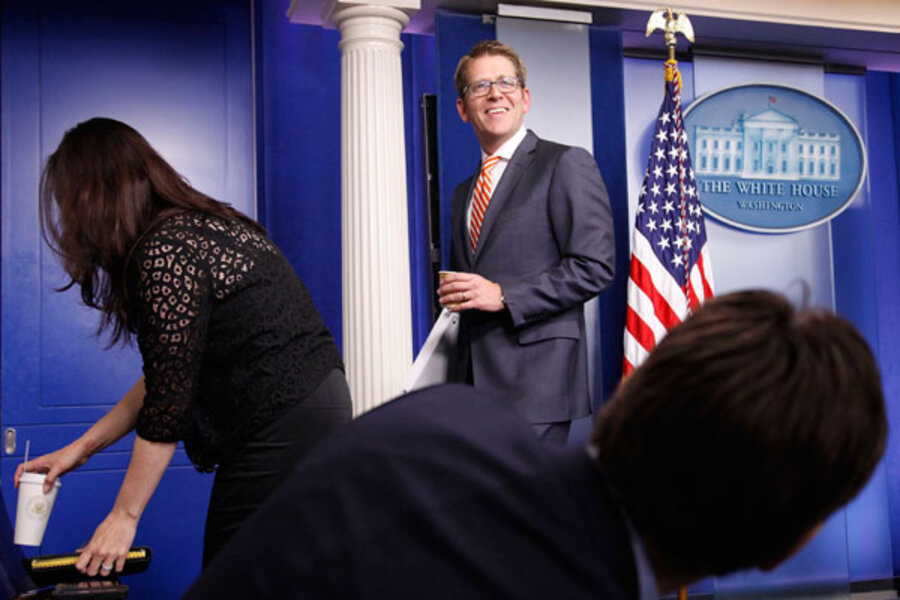Is White House taking cues from Soviets over Obama photos?
Loading...
| Washington
It finally happened. The White House press corps blew up at press secretary Jay Carney Thursday over the long-simmering issue of photographers’ access to President Obama.
In fact, Mr. Carney almost lost control of the daily briefing – often a staid exercise of precooked responses to predictable questions – as reporters piled on over the latest of many perceived slights toward White House press photographers.
During Nelson Mandela’s memorial service, none were allowed on the platform where Mr. Obama and his two immediate presidential predecessors sat during the service, unlike official White House photographer Pete Souza. And none were allowed into the front of Air Force One to snap any shots of the Obamas and their guests – including former President Bush and wife Laura – during the long flights to and from South Africa.
Mr. Souza captured many choice images of the Obamas, Bushes, and Hillary Rodham Clinton hanging together on Air Force One, admiring Mr. Bush’s artwork, and generally kicking back – as revealed in this Policymic.com photo essay.
OK, I know what you’re thinking: There goes the spoiled press corps, whining again about how it can’t have whatever it wants.
But this is actually a serious issue, one that the director of photography for the Associated Press opined on in Thursday’s New York Times, in an article called “Obama’s Orwellian image control.” Santiago Lyon called the Obama administration “undemocratic” and “hypocritical” in the way it has “systematically tried to bypass the media by releasing a sanitized visual record of [Obama’s] activities through official photographs and videos, at the expense of independent journalistic access.”
In October, a delegation from the White House Correspondents’ Association visited Carney to complain about photographers being shut out of events photographed by Souza. Times photographer Doug Mills slapped down a stack of Souza photos for emphasis.
“You guys are just like Tass,” the Russian news agency, Mr. Mills said to Carney, according to National Journal.
Ouch. Carney was a Moscow correspondent for Time magazine during the Soviet era.
Last month, the correspondents’ association weighed in.
“As surely as if they were placing a hand over a journalist’s camera lens, officials in this administration are blocking the public from having an independent view of important functions of the Executive Branch of government,” said the Nov. 21 letter to Carney.
On Nov. 5, this reporter had her own brush with the Obama administration’s limits on press access. It was the first day of renewed public tours of the White House, and president and Mrs. Obama decided to greet the visitors themselves. But the press “pool” in which I was serving that day – the small rotation of reporters, photographers, and TV cameras that follow the president – was not invited.
Instead, the event was live-streamed at WhiteHouse.gov. Maybe that’s good enough? White House reporters say no. When the president is performing his official duties in public, the pool should be there – even for just a minute or two.
On Thursday, when the Times op-ed appeared, Carney was ready for the questions.
“Let me tell you at the start here that from the president on down, everyone here believes strongly in the absolute necessity of a free and independent press to cover the presidency, to cover the government, to cover Washington,” he said.
Carney insisted that the press office went to “great lengths” to secure access for press photographers at the Mandela service – and that, in fact, they got “exceptionally more access” than they thought would be possible.
The press corps didn’t seem convinced. Some photographers who had gathered to watch looked bemused. And Carney didn’t exactly endear himself to them when he pointed out that the Internet has made it super easy to go around paid media and distribute photographs. He said he was “very sensitive” to the pressure on media business models.
In the end, Carney relented, kind of, on the issue of access during the trip to South Africa – and in general: “I would say broadly that in retrospect I think we can always find occasions where I would agree that we should have or could have or might have found a way to provide more access.”
We’ll see.








